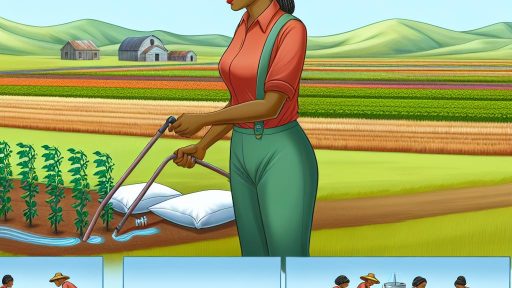Introduction to Crop Rotation and Diversity in Agriculture
The Importance of Crop Rotation
Crop rotation enhances soil fertility and structure.
It reduces soil erosion by maintaining ground cover.
Furthermore, it interrupts pest and disease cycles.
Benefits of Agricultural Diversity
Diversifying crops increases resilience against climate change.
It creates a balanced ecosystem that supports beneficial organisms.
Additionally, diverse crops can improve overall yield stability.
How Crop Rotation Works
Farmers alternate different crops in a specific sequence.
This practice replenishes nutrients and decreases reliance on fertilizers.
Moreover, it helps in managing weed populations effectively.
Diversification Techniques
Intercropping involves growing two or more crops in proximity.
This method maximizes land use and minimizes growth competition.
Cover cropping protects soil during off-seasons.
Case Studies and Real-World Applications
Successful farms around the world utilize these methods.
For instance, the Baker family farm reports improved yields with rotation.
Similarly, the Harmony Valley Co-op emphasizes crop diversity.
Transform Your Agribusiness
Unlock your farm's potential with expert advice tailored to your needs. Get actionable steps that drive real results.
Get StartedThe Role of Technology
Modern tools help track crop health and soil conditions.
Precision agriculture supports tailored crop treatment strategies.
This technology enhances the efficiency of rotation and diversity practices.
Benefits of Crop Rotation: Improving Soil Health
Enhancing Nutrient Availability
Crop rotation significantly enhances nutrient availability in the soil.
Diverse crops have varied nutrient requirements, which helps balance soil fertility.
This approach reduces the depletion of specific nutrients.
As a result, farmers can minimize the need for synthetic fertilizers.
Controlling Pests and Diseases
Crop rotation effectively controls pests and diseases.
Different crops can interrupt the life cycles of harmful organisms.
This practice reduces pesticide usage over time.
Consequently, it promotes a healthier ecosystem.
Improving Soil Structure and Erosion Control
Crop rotation contributes to improved soil structure.
Root systems from various plants help bind the soil together.
This binding action reduces soil erosion.
Moreover, it enhances water retention and infiltration.
Boosting Biodiversity
This practice boosts biodiversity within agricultural systems.
Increased crop diversity attracts beneficial insects and wildlife.
As a result, ecosystems become more resilient to environmental stressors.
Healthy ecosystems can better withstand climate change effects.
Long-Term Economic Benefits
Crop rotation offers long-term economic advantages to farmers.
By improving soil health, it increases crop yields over time.
This leads to higher profits and reduced input costs.
Farmers experience greater sustainability in their operations.
Impact of Crop Diversity on Pest and Disease Management
Benefits of Crop Rotation
Crop rotation significantly disrupts pest life cycles.
Showcase Your Farming Business
Publish your professional farming services profile on our blog for a one-time fee of $200 and reach a dedicated audience of farmers and agribusiness owners.
Publish Your ProfileBy changing crops, farmers reduce the chances of pest establishment.
Moreover, different plants attract diverse insects, which can control harmful species.
In addition, crop rotation improves soil health and reduces nutrient depletion.
This method promotes a balanced ecosystem on the farm.
Enhancing Natural Enemies
Diverse cropping systems support natural pest predators.
For example, planting flowers alongside crops attracts beneficial insects.
These insects help manage pest populations naturally.
Furthermore, diversity ensures a continuous food supply for these natural allies.
This balance reduces the reliance on chemical pesticides.
Minimizing Disease Risk
Pests often transmit diseases, and rotating crops disrupts their life cycles.
Different plants have varying susceptibility to diseases.
This diversity can therefore protect susceptible species from infection.
Additionally, farmers can implement resistance strategies in crop selection.
Implementing Integrated Pest Management
Crop diversity is a key component of integrated pest management (IPM).
IPM combines biological, cultural, and chemical practices.
By incorporating diverse crops, farmers can enhance the effectiveness of IPM strategies.
Diverse cropping patterns reduce pest outbreaks and provide resilience.
Ultimately, this approach leads to improved yields and environmental health.
You Might Also Like: Crop Rotation Techniques for Long-Term Soil Fertility
Economic Advantages of Crop Rotation and Diversity
Enhancing Soil Fertility
Crop rotation improves soil fertility significantly.
Diverse crops contribute different nutrients to the soil.
This practice restores essential elements like nitrogen and potassium.
As a result, farmers need fewer chemical fertilizers.
Consequently, this reduces overall farming costs for producers.
Reducing Crop Losses
Crop diversity effectively minimizes pest and disease outbreaks.
When crops are rotated, pests struggle to survive.
This leads to reduced dependence on pesticides.
Farmers like Samantha Greene report lower crop losses.
Reduced losses mean higher profits for agricultural businesses.
Increased Market Opportunities
Diverse cropping systems open up new market opportunities.
Growers can cater to niche markets for organic or specialty crops.
This flexibility allows for higher selling prices and profits.
In turn, it enhances local economies significantly.
Furthermore, crop diversity can attract agritourism.
Improving Water Management
Crop rotation plays a crucial role in improving water management.
Diverse root structures help maintain soil moisture levels.
This leads to reduced irrigation requirements in many cases.
It also minimizes soil erosion, preserving critical water resources.
Farmers, like Jacob Lindholm, experience lower water costs.
Showcase Your Farming Business
Publish your professional farming services profile on our blog for a one-time fee of $200 and reach a dedicated audience of farmers and agribusiness owners.
Publish Your ProfileSupporting Risk Management
Diverse cropping systems provide a buffer against market fluctuations.
Farmers can switch to more profitable crops as needed.
Additionally, rotation reduces economic risks associated with monoculture.
This flexibility leads to more stable income year-round.
Consequently, farmers can better invest in long-term projects.
Explore Further: Conservation Tillage Tools Every Farmer Should Know
Case Studies: Successful Implementations of Crop Rotation
The Williams Family Farm
The Williams Family Farm in Iowa adopted crop rotation in their practices.
Initially, they grew corn and soybeans in alternating years.
Over time, they introduced legumes and wheat into the rotation.
This change significantly improved soil health and increased yields.
As a result, the farm reported a 30% increase in overall productivity.
Additionally, they saw reduced pest populations and lower fertilizer costs.
Clyde Organic Farms
Clyde Organic Farms successfully implemented a diverse crop rotation strategy.
They experimented with a variety of cover crops each season.
These include clover, rye, and buckwheat among others.
Farmers noticed enhanced soil structure and nutrient availability.
This method increased organic matter in the soil by nearly 40% over three years.
Smithson Cooperative
Smithson Cooperative, located in Pennsylvania, focuses on rotational grazing and cropping systems.
They alternate between grazing cattle and planting diverse crops.
This practice enhances grassland health and crop yield stability.
Members reported a remarkable reduction in soil erosion.
Moreover, this system has led to increased animal health and reduced feed costs.
Research and Findings
Numerous studies support the benefits of crop rotation.
Research by the University of California illustrates yield improvements.
It found that crop rotation consistently enhances plant health and soil fertility.
These findings support the practices adopted by successful farmers.
Embracing diversity in planting can lead to sustainable agricultural practices.
Uncover the Details: Using Terracing to Improve Water Conservation on Slopes

Selecting Suitable Crop Varieties for Rotation
Understanding Crop Rotation
Crop rotation involves growing different crops in a specific sequence.
This method enhances soil health and reduces pest populations.
Moreover, it helps manage crop diseases effectively.
Benefits of Crop Diversity
Diverse crops contribute to a balanced ecosystem.
They attract beneficial insects and promote nutrient cycling.
Additionally, diverse root structures improve soil structure.
Factors to Consider When Selecting Varieties
Choose crop varieties based on local climate and soil type.
Assess pest and disease resistance of each variety.
Furthermore, consider the market demand for selected crops.
Popular Crops for Rotation
- Legumes, such as beans and peas, enrich soil nitrogen.
- Cereals like corn and wheat provide substantial biomass.
- Root crops, including carrots and beets, aerate the soil.
Consulting Agricultural Experts
Seek advice from local agricultural extension services.
These experts offer valuable insights on crop selection.
Furthermore, they can provide tailored recommendations based on local conditions.
Showcase Your Farming Business
Publish your professional farming services profile on our blog for a one-time fee of $200 and reach a dedicated audience of farmers and agribusiness owners.
Publish Your ProfileEvaluating Your Crop Plan
Regularly assess the performance of crop rotations.
Adjust your plan based on yield data and soil tests.
Moreover, remain flexible and adapt to changing conditions.
You Might Also Like: Permaculture Farm Planning Strategies For Optimal Yield
Best Practices for Implementing Crop Diversity on Farms
Understanding Crop Rotation
Crop rotation involves alternating different crops in the same space across seasons.
This practice enhances soil fertility and disrupts pest cycles.
Farmers should plan rotations based on crop families and nutrient needs.
Including legumes in the rotation can improve soil nitrogen levels.
Incorporating Cover Crops
Cover crops are vital for maintaining soil health during off-seasons.
They prevent erosion and suppress weeds effectively.
Farmers can select cover crops suited to their climate and soil conditions.
These crops also contribute organic matter to the soil when turned under.
Emphasizing Biodiversity
Biodiversity on farms can increase resilience against pests and diseases.
This involves growing multiple species of crops together.
Intercropping can maximize land use and improve overall yields.
Farmers should also consider planting pollinator-friendly species to boost pollination.
Utilizing Integrated Pest Management
Integrated Pest Management (IPM) combines ecological principles for pest control.
This method reduces reliance on chemical pesticides.
Farmers can incorporate natural predators to manage pest populations.
Additionally, rotating crops disrupts pest life cycles and reduces infestations.
Educating and Training Staff
Training farm staff is essential to successfully implement crop diversity practices.
Farmers should provide education on the benefits of rotation and diversity.
Workshops and field days can enhance skills and knowledge among workers.
Encouraging teamwork fosters innovative solutions for specific farming challenges.
Monitoring and Evaluating Outcomes
Regular monitoring helps in assessing the effectiveness of crop diversity strategies.
Farmers should track yields, soil health, and biodiversity indicators.
Adjustments may be necessary based on observations and results.
Using this data, farmers can refine their practices for better outcomes.
Challenges and Solutions in Adopting Crop Rotation and Diversity
Understanding the Barriers
Farmers often face economic constraints when implementing crop rotation.
This difficulty arises from the potential short-term loss of income.
Additionally, lack of knowledge can hinder adoption among smaller farmers.
Moreover, few resources exist to guide farmers through this process.
Soi and Climate Adaptations
Different crops require varying soil types and climates.
This variability makes planning rotations challenging for farmers.
Moreover, changed weather patterns can affect traditional rotation schedules.
Farmers must adapt to these shifts to maintain productivity.
Finding Solutions
Education plays a critical role in overcoming adoption barriers.
Workshops and online resources can enhance farmer knowledge.
Additionally, partnering with agricultural extension services can provide key support.
Economic Incentives
Government programs can help ease financial burdens for farmers.
Showcase Your Farming Business
Publish your professional farming services profile on our blog for a one-time fee of $200 and reach a dedicated audience of farmers and agribusiness owners.
Publish Your ProfileSubsidies for diversifying crops encourage sustainable practices.
Furthermore, cooperatives can offer shared resources to reduce costs.
Building Community Support
Local farming communities can foster knowledge sharing.
Networking allows farmers to discuss successes and setbacks.
Moreover, collaborative crop planning can enhance community resilience.
Additional Resources
What is Sustainable Agriculture? | Union of Concerned Scientists




